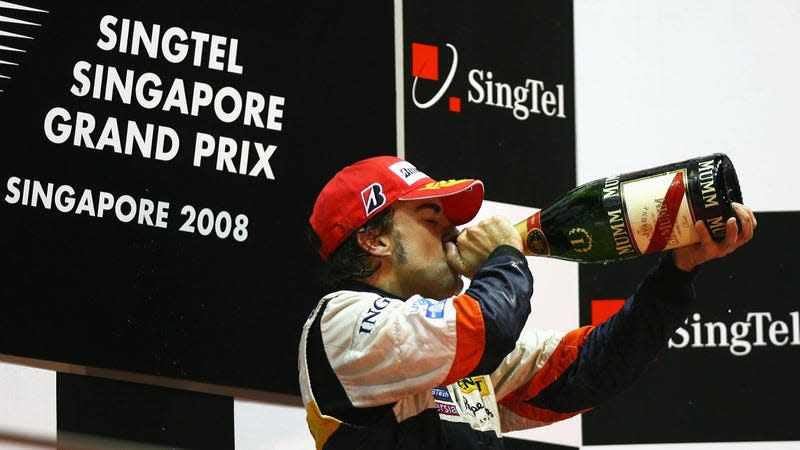These F1 Drivers Avoided a Penalty for Breaking the Rules

At the 2023 Saudi Arabian Grand Prix this year, odd officiating by the FIA resulted in Fernando Alonso receiving a penalty, only to have that penalty overturned after his podium position trophy had been given away to George Russell. It’s not the first time Formula 1 and/or the FIA has been unclear on its own rules. In fact, the history of the sport is littered with even more egregious examples. Today, we’re talking about the F1 drivers that should have been penalized for a particular breach of the rules but weren’t.
This list is ordered from most to least recent, and it includes all actions that should have been penalized but wasn’t, whether those actions went unnoticed, were thrown out after argument, or resulted from officials not knowing the rulebook.
Read more
Fernando Alonso
Crashgate Explained: The Scandal in Singapore
Race: 2008 Singapore Grand Prix, 2003 Brazilian Grand Prix
I don’t think anyone would be surprised to find out that ol’ Fernando Alonso has been the subject of not one but two avoided penalties throughout his time in F1.
Let’s start with the 2003 Brazilian Grand Prix. Mark Webber had crashed near the end of the race, and Alonso ignored the yellow flags that had been displayed; as a result, he claimed he plowed into debris from Weber’s crash at “close to full speed.” The race was red-flagged.
Failing to observe a yellow flag should have resulted in a penalty for Alonso, but after a few days of deliberation, the FIA had allowed Alonso to keep his third-place finish, perhaps because they bought into Alonso’s claims that he believed the yellow flags were for a crash behind him.
And then, of course, there was Alonso’s role in the chaotic 2008 Singapore Grand Prix. Allegedly, Renault asked Alonso’s teammate Nelson Piquet Jr. to intentionally crash, bringing out a safety car in order to aid Alonso, who had been forced into an early pit stop. Dubbed “Crashgate,” the incident saw Renault fined; according to the rules, Alonso’s victory should have also been revoked, but the FIA allowed him to keep it.
Michael Schumacher
SCHUMACHER RETURNED - 1999 Malaysian Grand Prix
Race: 1999 Malaysian Grand Prix
At the 1999 Malaysian Grand Prix, the FIA initially disqualified the Ferrari team (which had finished 1-2) because its cars were sporting oversized bargeboards. Ferrari appealed the penalty, saying the bargeboards fell within the five millimeter tolerance allowed by the FIA rulebook; the FIA relented, and Ferrari’s finishing positions for Michael Schumacher and Eddie Irvine were reinstated.
Eddie Irvine
1999 F1 Malaysian GP ITV post-race show
Race: 1999 Malaysian Grand Prix
Eddie Irvine suffered the same overturned penalty as Schumacher listed above, and his finishing position was reinstated for the same reason.
Ayrton Senna
AND IT’S HAPPENED IMMEDIATELY! The Story of the 1990 Japanese Grand Prix
Race: 1990 Japanese Grand Prix
The Ayrton Senna/Alain Prost duel provided some of the spiciest moments in Grand Prix history, including the first corner crash between the two drivers at the 1990 Japanese event.
There was a lot of context that went into Senna’s seemingly intentional crash. First, he was displeased that pole position would be lining up on the “dirty” side of the track, while second place would be starting from the preferred position; Senna’s pole, therefore, would have come as a detriment. Second, he was mad that, the year prior, Prost had crashed into him and denied Senna a Championship. The two drivers had generated a lot of title animosity at the Japanese circuit. Senna should have been penalized for the seemingly intentional move, but he was allowed to secure the Championship through the move.
Alain Prost
1986 German Grand Prix - Turbos & Tantrums
Race: 1986 German Grand Prix
Leaving the cockpit of your vehicle and pushing your car across the finish line was made illegal in Formula 1 decades earlier, but that didn’t stop Alain Prost from trying that very move at the 1986 German Grand Prix, when his car ran out of fuel with just 100 meters remaining to the finish line. As a result, Prost should have been penalized, but the FIA could be very lax about the enforcement and punishments regarding the pushing rule.
Thierry Boutsen
Grand Prix Greats – The crazy end to the 1985 San Marino GP
Race: 1985 San Marino Grand Prix
Another lax pushing rule came into play at the 1985 San Marino Grand Prix. Thierry Boutsen was one of several drivers to run out of fuel at the very end of the race, and he responded by getting out of his car and pushing it across the line at the end of the race. The FIA opted against punishing him, and Boutsen got to keep his second-place finish.
Nigel Mansell
F1 1984 R09 - US Dallas - Highlights
Race: 1984 Dallas Grand Prix
As mentioned above, pushing your car was a most definite no-go for the FIA by 1984, but the sanctioning body yet again turned a blind eye in the case of Nigel Mansell pushing his car across the finish line at the 1984 Dallas Grand Prix. Presumably, the series decided he’d suffered enough, having passed out from heat exhaustion.
Rolf Stommelen
1976 German Grand Prix highlights
Race: 1976 German Grand Prix
While there’s a good chance you remember the 1976 German Grand Prix most for Niki Lauda’s near-fatal accident, it was also the location of a penalty that went unpunished. Rolf Stommelen set his best practice time behind the wheel of a Brabham BT44B-Cosworth, but when he lined up for the race, he was behind the wheel of a BT45-Alfa Romeo. That change of cars should have caused him to start from the back of the grid, but he was allowed to keep his original starting position. He ended up sixth in the race.
James Hunt
1976 Spanish Grand Prix highlights

 Yahoo Autos
Yahoo Autos 